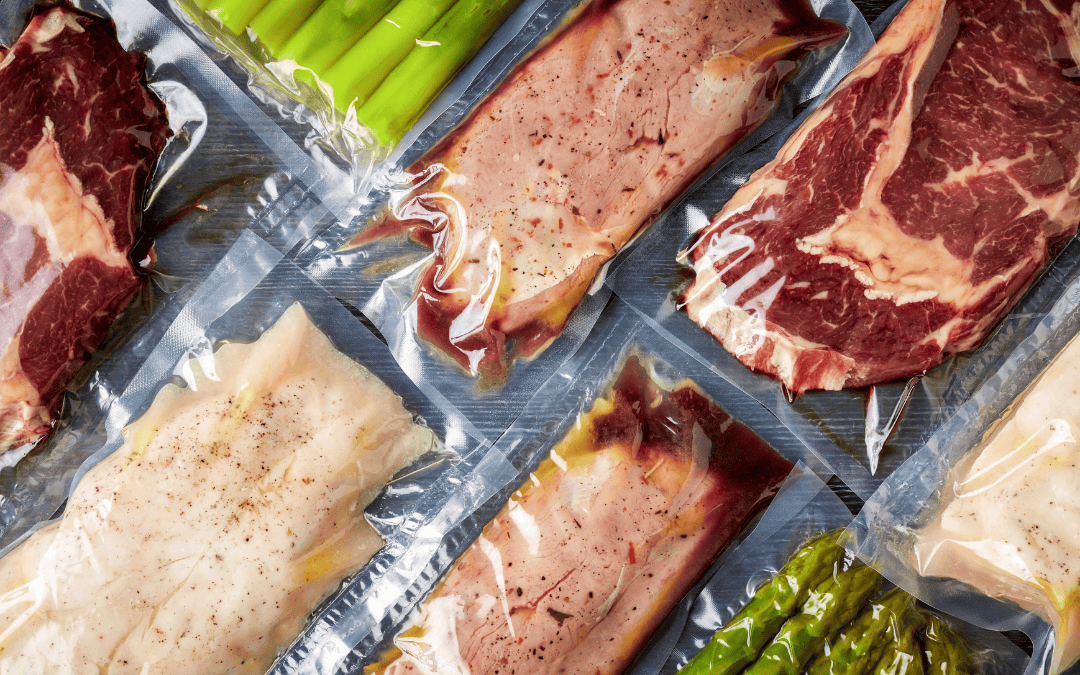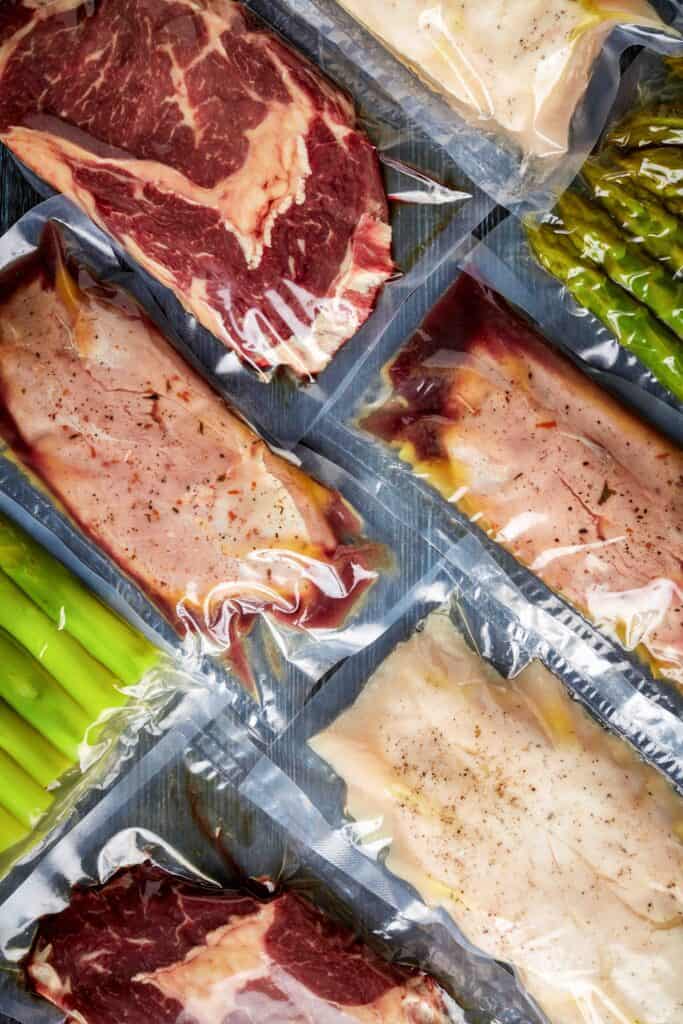You are reading a paid Steam Oven Insiders member newsletter. Insiders newsletters drop into your inbox on the 15th and 30th of each month. The next issue will be about Sourdough Bread in a Steam Oven.
Editor’s note
Hello!
We have a few new Insiders this month – if you’re one of them, welcome and thanks for joining us! I hope you’ve had a look through some of the previous newsletters and are already getting value from being here.
Today’s newsletter is all about sous vide cooking. More specifically, sous vide cooking using a steam oven. It’s a pretty big topic so I’ve broken it down to bare bones as much as I can.
I’ll take you through what sous vide actually is, then go on to the advantages of using your steam oven to achieve great results from the method. If you’ve never cooked a single thing sous vide style before, I think this will inspire you to try. Sounds fancy, but it’s really just another way to prepare delicious meals (and it has some serious benefits when it comes to preparing food ahead of time!).
There are plenty of resources and links out to ‘sous vide things’ in this issue, so if you’d like to go deeper into the topic those will keep you busy for weeks! As ever, if you have follow-up questions around this subject, send me an AMA email (details at the end of this newsletter) and I’ll try my best to answer it in the next issue.
Happy steam oven cooking, see you again in a couple of weeks.
Emily x
Sous vide cooking is loved for its precision, consistency, and ability to create restaurant-quality dishes in your own kitchen. The method involves cooking food in a temperature-controlled water bath (or steam oven!), allowing for the retention of flavor, texture, and nutrients.
Today, I’ll delve into the differences between water bath sous vide and steam oven sous vide; the best foods for the different methods; and food safety considerations to be aware of when using this innovative cooking technique. If you’d like to delve deeper into the topic, I’ve also curated a list of my favorite sous vide resources at the end of the article.
Sous vide corn is almost not a recipe at all! But I want you to give it a try. Sous vide corn is So. Much. Better. than any other way you’ve ever cooked corn on the cob. I know it takes longer, but the payoff is sweeter, more ‘pop-y’, bright yellow kernels that have been cooked at exactly the right temperature to convert starches into sugars through a process called gelatinization.
And here’s the steam oven sous vide twist: instead of vacuum sealing your corn, use nature’s packaging and cook it still wrapped in the husk. My evidence of this is anecdotal, but I truly believe it improves the flavor further because you get a different, subtly herbal note imbued into the corn while it cooks. Cut the stalk end off after cooking and you can simply squeeze the entire cob out of the husk, leaving those pesky strands of corn silk behind.
But wait; a bonus recipe!
You’ll need something to serve that corn with, and I recommend sous vide steak with this wonderful, versatile ‘Everything’ Marinade.
(Want the sous vide steak directions, too? Those can be found over on the Steam & Bake recipe index).
The Season Flip
Your mind might be spinning at this point, with all the things you can learn about sous vide cooking! Here are a couple of specific ideas for things to try out.
Southern Hemisphere
Coming into Spring, not much excites me more than the arrival of the first snappy little asparagus spears at the greengrocer or farmers market. Lucky, then, that sous vide and asparagus are great buddies. Keep it simple with butter and lemon, and serve your asparagus with pretty much everything while it’s in perfect season.
Northern Hemisphere
I love the combination of beets and citrus, and it’s heading into peak time for both in the Northern climes. Make the most of it with this composed salad; sous vide cooking your beetroot retains sweetness and a lovely texture all the way through each piece.
A Thing I'm Loving

There are lots of things I use, eat, read about and enjoy in the kitchen that aren’t specifically related to steam ovens! Perhaps you’d like to know about some of them?
This is not so much a kitchen thing, but it goes in the dining area so it’s related: I’m loving inbuilt bench seating for dining areas; so much that I’m having some built for my house! We have a smallish and awkwardly positioned dining area, and L-shaped inbuilt seating is how I plan to resolve the issue of needing to fit a larger table in the space. I didn’t realize there were so many options for this kind of seating, though. Floating seating to make the space appear bigger, or floor-set to allow for storage under the seats? Fabric cushions or leather (or none at all!)? Angled backs or do we let the wall become the seat back? If you’ve got a bench seat in your dining area, send me a photo, I’d love to see it!
(Nope, that’s not my kitchen above. But that’s the kind of thing I’m going for)
*note: some of the links to A Thing I’m Loving are affiliate links, meaning I make a small commission if you make a purchase from that business. But rest assured I will never, ever share something I don’t personally recommend.
Ask Me Anything (AMA)
Here’s your opportunity to ask me anything you like related to combi steam cooking!
I really encourage you to submit questions, and will do my best to answer as many as possible. Though I may not be able to get to every single question, I will carefully curate ones which are relevant and represent a variety of topics. We all learn from each other, and I often learn new things based on questions from all of you!
If you have an AMA question, please email it to [email protected]. Make sure you include the phrase INSIDERS AMA in the subject line so I can collate and read all your submissions.
I have had a couple of queries about whether prior AMA questions and answers can be collated somewhere on the Insiders website (not just inside the newsletters). It’s a great idea; bear with me while I figure out the best way to format it and make that happen!
This edition’s questions:
From Susan
Q: I would like to understand what plastic and/or products to use when doing sous vide in my Vzug Combi Steam. I’m particularly interested in the health side of the various plastic wraps, zip lock bags, silicone products etc. Which items should I NOT use because of the chemical hazards?
A: This is a minefield, I’m afraid! There are a few things I know to be true, but because I don’t frequently use a lot of bags for sous vide, there are some factors I don’t know much about. Here’s my take, though:
Cling films like Glad Wrap are food safe by legal standards, but they warp and shrivel and, frankly, smell when exposed to high temperatures. There are chefs who swear by cling film for sous vide dishes where a protein needs to be tightly wrapped for shaping purposes but I prefer to steer clear.
Zip-loc or press seal bags are fine for relatively low temperature sous vide. Reputable brands do not include BPA’s. But they’re not great from the perspective of ‘bag failure’. The seals on the sides of the bags aren’t made for exposure to heat or too much pressure, so they do split from time to time when used for sous vide. Less of a big deal in a steam oven, but a very big deal if you’ve submerged food into a water bath to cook!
Silicone zip-loc bags have become popular for sous vide because they’re washable and reusable, and can tolerate high temperatures. I think health-wise they are perhaps the best of the bunch, however I find them fiddly to use and it’s hard to get all the air out of the bags before cooking.
Plastic bags for vacuum sealers vary a lot in composition, quality and efficacy. I do use them because they’re extremely convenient, especially if you want to go from oven to freezer. Opt for bags sold by reputable brands rather than generic bulk lots on Amazon or AliExpress, which may not have the same quality control in terms of materials used. I’ve most recently bought Anova’s branded bags and found them fine, plus I like that they are plastic neutral by way of a partnership with Plastic Bank.
From Deborah
Q: When I have attempted your Parmesan Crusted Chicken or Steam Oven Fish with Almond Crumbs, the flesh is moist, tender and delicious, but the crust is moist, not crispy. I use 400F and 435F respectively at 60% humidity— my oven temp maxes out at 435F. I could reduce humidity near the end but I’m not sure about timing and I don’t want to dry out or overcook the flesh. Please help.
A: As is often the case with oven brands and models, it sounds like your oven’s 60% humidity is different to my oven’s version of that same 60%! Although they might be called the same thing, frequently I find different ovens output different levels of humidity. It would be great if every manufacturer got together and created some kind of standard for this, but given that’s never going to happen for a host of reasons, it’s down to us to make adjustments in our cooking.
Rather than just reducing humidity at the end of cooking, in this case I’d manage the too-moist crumbs by reducing it down for the entire cook. Keeps it simpler and you don’t have to mess around with your oven settings partway through cooking. You’ll have to experiment to get your perfect combination of juicy chicken and crunchy crumbs, but I’d go as low at 30% to see if that gives a better balance. You may need to cook for an extra couple of minutes to ensure the chicken is cooked through. If the crumbs are still not crunchy, you could also try turning off the steam altogether for the last 5 minutes. If you do this, briefly open and then close the oven door when you turn off the steam, to vent excess moisture from the oven cavity.



